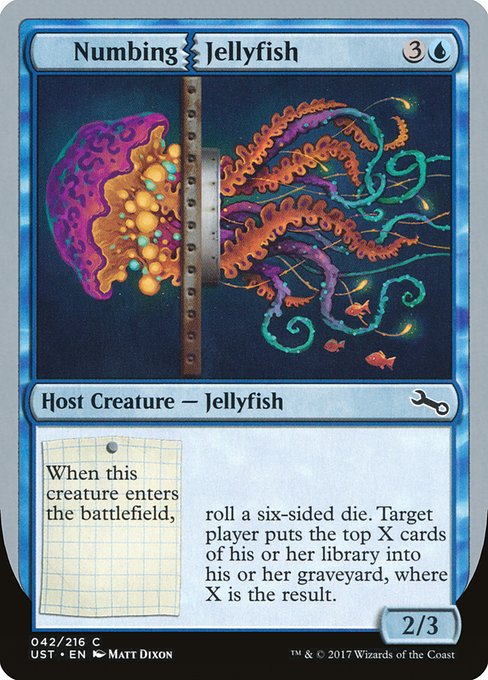
Image courtesy of Scryfall.com
Data-Driven Mana Efficiency: Measuring Numbing Jellyfish's Value
Blue has long thrived on control, card draw, and tempo, but the data says there’s more to mana efficiency than just a number on the stack. Numbing Jellyfish, a blue host creature from Unstable, arrives with a curious promise: pay {3}{U} (4 mana total) to summon a 2/3 jellyfish that triggers a die roll on entry, milling X cards for a target player where X is the roll of a six-sided die. That single ETB ability mixes randomness with a tangible library impact, turning every play into a little experiment 🧙♂️🎲. This is a perfect case study in how we evaluate “value per mana” in a format where randomness isn’t a bug, but a feature that must be measured and understood.
At first glance, the raw numbers look modest: 4 mana for a 2/3 body is tempo-negative by traditional creature standards. But the real value emerges from the ETB mill: the die determines X, so the expected mill is the average of 1 through 6, which is 3.5 cards. In other words, on average you’re turning 4 mana into 3.5 milled cards—a ratio of 0.875 cards per mana. That’s a useful metric, especially when compared across other blue options that seek to bend the same tempo with different rewards 🧙♂️💎.
To make this more concrete, imagine the typical 60-card library as a shallow reservoir you’re gently chipping away at. Milling 3.5 cards per cast isn’t a devastating blow to the opponent’s library like a full-game mill plan, but it’s a steady trickle that can accelerate fatigue in the late game, especially when combined with other mill or inevitability tools. The interesting question becomes: how often does the average align with the actual distribution you’ll see in games? The six-sided die gives a uniform distribution: each outcome from 1 to 6 has a probability of 1/6, with a standard deviation of about 1.71 cards. So while you expect 3.5 milled cards per trigger, any given game will deviate—sometimes you’ll glimpse 6 cards milled in one swing, other times only 1 or 2. That variance is where the fun GREETS the data nerd in us, because it informs risk assessment and deck-building choices 🎲🔥.
“In blue, randomness isn’t chaos; it’s a design space you can exploit with math and patience.”
From a design standpoint, Numbing Jellyfish is a warm reminder that mana efficiency isn’t just about raw numbers—it’s about synergy, pacing, and the psychology of expectation. The 4-mana, 2/3 body gives you a respectable—but not overwhelming—tempo presence. The ETB mill adds a deterministic element (the die roll) that creates variable value across matches and opponent archetypes. In practical terms, you’ll find this card most effective in games where mill themes aren’t the sole plan but rather a supplementary engine that accelerates a broader strategy. If your deck already leans into card advantage and library manipulation, Jellyfish becomes a multiplier on the back end, pushing games toward a finish line where even a modest average mill can tip the scales 💎⚔️.
Colloquially, we can think of Numbing Jellyfish as a data point that embodies a larger principle: mana efficiency is not a single stat but a curve that unfolds over a game’s timeline. The combination of a solid body, a reliable color identity (blue’s toolkit), and a probabilistic “on-entry” impact invites players to model their draws and plan around risk-reward thresholds. For players who enjoy weaving statistics into strategy, the card offers a playful sandbox where probability meets tempo. And yes, the art and flavor help sell the joke—the jellyfish’s entangled, shimmering silhouette pairs perfectly with a blue deck that’s both precise and a little chaotic 🎨🧪.
Applying the math in practical decks
In a hypothetical blue mill deck—where the goal is to deplete an opponent’s library while preserving your own resources—Numbing Jellyfish provides a flexible tempo play early on with a built-in randomness engine. You might pair it with card-draw engines or library manipulation to ensure you hit the higher rolls more often or to maximize coverage across multiple turns. The data-driven lens suggests that while you won’t reliably mill six cards every game, consistent 3–4 card mills with a moderately efficient body can create a reliable erosion of outs in the long game. Add accessories like draw-heavy or bounce-heavy support and you’ve got a multi-tool that scales with game state, not just mana availability 🧙♂️💫.
From a collector’s perspective, the Unstable printing also carries a unique artistic footprint. As a common in a silver-border, comedic set, Numbing Jellyfish is a reminder that design experimentation in MTG can be delightful and teachful in equal measure. If you’re cataloging set-specific experiences or exploring how “fun” cards perform in casual play, Jellyfish is a standout data point that blends math, chance, and whimsy into a single creature. And for players who like to track performance over time, it’s a card that rewards careful observation of outcomes, not just big hits or flashy turns 🧭🎲.
As you plan your next draft night or kitchen-table tournament, consider the value proposition of Numbing Jellyfish not as a stand-alone win condition but as a calculated increment in mana efficiency. The data suggests a balanced, if not explosive, payoff that respects blue’s broader design space—control, selection, and a touch of randomness that keeps every game fresh. If you’re chasing those optimistic, jackpot-like moments on a die roll, this jellyfish isn’t a one-trick pony; it’s a thoughtful, probabilistic instrument that can nudge a game from “maybe” to “definitely interesting” with every entry onto the battlefield 🧙♂️🎲.
Customizable Desk Mouse Pad (Rectangular, 0.12in Thick, One-Sided)More from our network
- A Hot Beacon in Sagittarius Guides High-Velocity Star Searches
- Exploring Color Balance Metrics in Un-sets Frenzied Baloth
- Timeless Construction, Modern Desk Presence: Custom Vegan PU Leather Mouse Pad
- Predictive Modeling for Chinchou Reprint Cycles in Pokémon TCG
- Open World Map Design: Crafting Immersive Exploration